当前位置:网站首页>TS 类型体操 之 extends,Equal,Alike 使用场景和实现对比
TS 类型体操 之 extends,Equal,Alike 使用场景和实现对比
2022-07-06 07:23:00 【Jioho_】
TS 类型体操 之 extends,Equal,Alike 使用场景和实现对比
在程序中,判断相等是一个很重要的内容,在 TS 中判断相等(其实是属于 xxx 范围) 用的是 extends。只用 extends 自然是不够,所以有很多工具类有一些很微妙的技巧来实现严格相等的功能
下面会讲到几个工具类
Equal和Alike。这 2 个并不是 TS 的官方实现,而且在 TS 体操练习的仓库里面大神封装的工具类
extends 的作用
先回顾一下 extends 的作用和多数的应用场景
// - 1
type ID = string | number
type TestID = ID extends string ? true : false // false
type TestID2 = string extends ID ? true : false // true
// - 2
type UnionType = string | number | boolean
type testUnion = string extends UnionType ? true : false // true
type testUnion2 = [string] extends [UnionType] ? true : false // true
type testUnion3 = [UnionType] extends [string] ? true : false // false
上面的 2 个例子中
ID 是 string/number 类型,所以 ID 取值的范围是比 string 类型的范围的大的,TestID 返回值自然为 false 了
而一个 string 类型,是 在 string|number 范围内的,所以自然为 true 了
其他在数组中的也是同理
用 extends 的特性解决 01097-medium-isunion
extends 是一个自带范围判断的判断符,只要在另外一个类型范围内,那就判定为 true
01097-medium-isunion 题目的需求:判断一个传入的类型是否 union 类型
什么是 union(联合)类型呢,就是由多个类型 联合而成,其中
|就是为了 粘合多个类型的
测试用例如下:非常有代表性
type cases = [
Expect<Equal<IsUnion<string>, false >>,
Expect<Equal<IsUnion<string|number>, true >>,
Expect<Equal<IsUnion<'a'|'b'|'c'|'d'>, true >>,
Expect<Equal<IsUnion<undefined|null|void|''>, true >>,
Expect<Equal<IsUnion<{ a: string }|{ a: number }>, true >>,
Expect<Equal<IsUnion<{ a: string|number }>, false >>,
Expect<Equal<IsUnion<[string|number]>, false >>,
// Cases where T resolves to a non-union type.
Expect<Equal<IsUnion<string|never>, false >>,
Expect<Equal<IsUnion<string|unknown>, false >>,
Expect<Equal<IsUnion<string|any>, false >>,
Expect<Equal<IsUnion<string|'a'>, false >>,
]
根据上面 extends 的介绍,我们就可以利用下面的原理解决这个问题
string extends string | number为 truestring | number extends string为 false- TS 体操中的 Union(联合类型)会自动 “解构”
答案如下:
type IsUnion<T,U = T> = T extends U ? U extends T ? false : true : false
在 IsUnion 里面,T 会自动的 “解构”,就比如 传入的是 string|number。
- T 会自动变成 string,然后和 U 进行比较
- T 在变成 number ,在和 U 比较
- U 同理 变成 string 和 T(string/number) 进行比较
所以看上去 T extends U 只是一个三目运算符,实际上他们已经运行 4 次比较了,只要有一次为 false,那 extends 的结果就为 false
不信?插个题外话证明下
我们把类型换成 'a' | 'b', 这个也是个 union 类型,然后我们把 extends 换成他们 2 个拼接
type TestUnion<T extends string, U extends string = T> = `${T}-${U}`
type ResultUnio = TestUnion<'a' | 'b'>
// type ResultUnio = "a-a" | "a-b" | "b-a" | "b-b"
看到结果后,应该就能理解上面说的,union 类型会自动的 “解构” 的意思了把,T 会自动解构为 a 和 b,U 也会自动解构为 a 和 b,然后两两配对组合;最终得出结果(不明白的在琢磨琢磨)
能理解这个 demo 后,后面还有几道题会用到这个知识点,圈起来要考
题外话结束
说回测试用例的几个例子
{ a: string|number }和[string|number]不是联合类型,因为他们其实都属于同一个对象下的,他们的属性值是联合类型,而他们自身并不是剩下的最后 4 个测试用例中,比如
string|never,string|'a'也是不符合 多个类型联合 的意义- never 说明没有一个类型符合,就好像绝育的小猫咪和正常的小猫咪还能生出新的小猫咪吗?不行的嘛。所以他们不能联合
- 至于
string|'a'‘a’ 本来就是属于 string 类型的,这就好像 一只公的小猫和一只公的黑色小猫,他们能 联合 吗?他们都属于公猫,只有并集,联合不出来结果 - 所以
string|any同上面同理,any 包罗一切,没有东西可以和 any 组成联合
但是!他们虽然不能组成联合类型,但是这不会报错,像这种 脱裤子放屁的操作
TS 会自动帮他们取范围比较大的一个类型作为联合结果
就好比 一只公的小猫和一只公的黑色小猫,他们统称为 公猫
type StringUnion = string | 'a' // 结果为 string
type StringUnion2 = string | any // 结果为 any
使用小技巧实现 Equal 全等判断
要说 Equal 的使用场景,TS 类型体操的练习题每一题都用到了
type User = {
name?: string
age: number
address: string
}
type User2 = {
name?: string
} & {
age: number
address: string
}
type R = Equal<User1, User2> // false
type R2 = User1 extends User2 ? (User2 extends User1 ? true : false) : false // true
看上面的 demo,如果仅用 extends 来判断,他们是相等的(U1 == U2 && U2 == U1)
可是写法上确实有差别,User2 是通过交叉类型交叉在一起的
这也就是为什么 extends 做不了完全相等的原因
所以就出现了 Equal 的方案,看看 Equal 的实现
export type Equal<X, Y> =
(<T>() => T extends X ? 1 : 2) extends
(<T>() => T extends Y ? 1 : 2) ? true : false
一开始我也琢磨了很久
- T 是那里冒出来的?
- T 是作为泛型,传入一个函数内,然后在返回出来?
- T 为什么会等于 X ?
- T 又为什么等于 Y 了 ?
最后在这里看到了答案,略有感悟 How does the Equals work in typescript?
根据有括号先看括号的原则 把 Equal 的等式分成 3 段内容来看
(<T>() => T extends X ? 1 : 2)假设为 1 式(<T>() => T extends Y ? 1 : 2)假设为 2 式
连起来看就是 : 1式 extends 2式 ? true : false
而 <T>() 怎么理解呢?有一句很重要的话 (也是摘自 stackoverflow 上的答案)
The assignability rule for conditional types <…> requires that the types after extends be “identical” as that is defined by the checkerF
对应翻译: 条件类型 <…> 的可分配性规则要求扩展后的类型与检查器定义的类型“相同”
根据上面说的 1式,2式 来个 demo 理解下:
declare let x: <T>() => T extends number ? 1 : 2
declare let y: <T>() => T extends number ? 1 : 2
declare let z: <T>() => T extends string ? 1 : 2
var str: string = '1'
str = 2 // 报错
x = 100 // 报错
x = y
x = z // 报错
y = z // 报错
- 2 赋值给 str 时会报错 Type ‘number’ is not assignable to type ‘string’.
- x 赋值为 100 时会报错 Type ‘number’ is not assignable to type ‘<T>() => T extends number ? 1 : 2’.
仔细观察这 2 个错误消息,他们都属于
ts(2322)号错误。那么就可以理解为<T>() => T extends number ? 1 : 2实际上和string一样,是一个单一类型,而不是我们认为的函数
y 赋值给 x 啥事都没有
z 赋值给 x 和 z 赋值给 y 都会提示下面的错误
Type '<T>() => T extends string ? 1 : 2' is not assignable to type '\<T\>() => T extends number ? 1 : 2'.
Type 'T extends string ? 1 : 2' is not assignable to type 'T extends number ? 1 : 2'.
Type '1 | 2' is not assignable to type 'T extends number ? 1 : 2'.
Type '1' is not assignable to type 'T extends number ? 1 : 2'.
说白了就是不同类型的不能赋值,因为 可分配性规则要求扩展后的类型与检查器定义的类型“相同”
看到这里,是不是大概就理解了?1 式 和 2 式其实最后只是一个写法比较夸张的 类型。而后面接的小尾巴(1 和 2,也真的是为了凑字数,为了 extends 凑齐字数用的)
比如稍微改一下,等式就全都报错了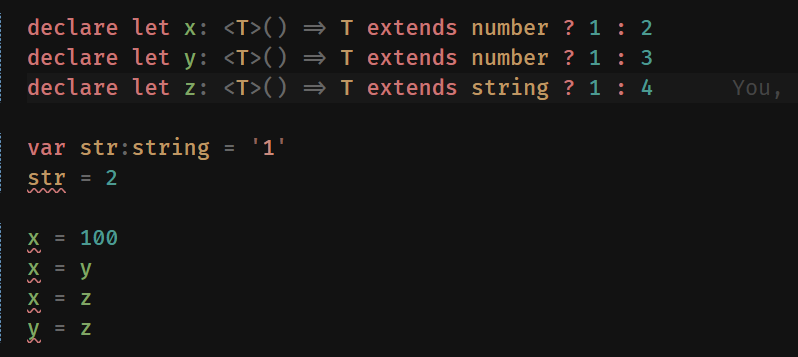
而改一下泛型的定义,倒不会报错
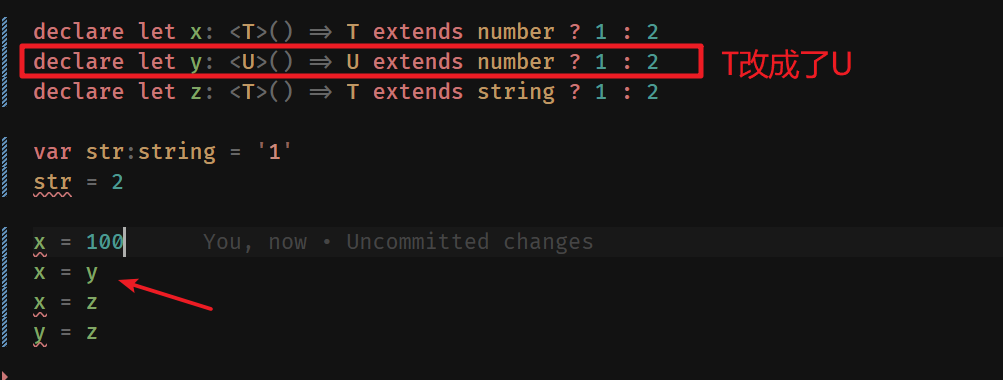
总结起来还是那句话
条件类型 <…> 的可分配性规则要求扩展后的类型与检查器定义的类型“相同”
看懂了 demo 和解析的文字,那么看懂 Equal 也不在话下了,只要 1 式和 2 式 extends,在基于上面的“相同”特性,那就是全等了
和 Equal 很像的 Alike
Alike 和 Equal 一样是为了判断相等的,在之前一篇文章 《TS 类型体操 之 循环中的键值判断,as 关键字使用》 中有讲过 
type User = {
name?: string
age: number
address: string
}
type User2 = {
name?: string
} & {
age: number
address: string
}
// 把 Equal 换成 Alike 得到的就是 true 的结果
type R = Alike<User1, User2> // true
type R2 = User1 extends User2 ? (User2 extends User1 ? true : false) : false // true
如果用 Alike,那么刚才 Equal 为 false 的 2 个对象又能重新变为 true 了
Alike 不能就单纯的理解是就是 T extends U && U extends 的实现,绝对不能
- Alike 实现如下:
export type MergeInsertions<T> = T extends object ? {
[K in keyof T]: MergeInsertions<T[K]> } : T
export type Alike<X, Y> = Equal<MergeInsertions<X>, MergeInsertions<Y>>
使用了 MergeInsertions 的工具类,这个的作用和昨天讲的 type Clone<T> = Pick<T, keyof T> 差不多!只是说我的 Pick 只能 Pick 一层,而 MergeInsertions 则是考虑到了对象多层嵌套的情况(升级版 Clone,有点浅拷贝和深拷贝的意思)
{} & {} 经过 MergeInsertions 处理后,也会被合并为一个对象 {},然后在拿去 Equal 对比。不得不说,真是妙
上面提到 Alike 不能就单纯的理解是就是 T extends U && U extends 的实现
看个案例:
type TestUnion = {
a: string } | {
a: number }
type IsLike = Alike<TestUnion, TestUnion> // true
type IsUnionResult = IsUnion<TestUnion> // true
type IsLike2 = Alike<string, string> // true
type IsUnionResult2 = IsUnion<string, string> // false
对于单一类型,T extends U && U extends 可以判断出是否 Union ,而 Alike 只能判断他们是否相等
所以要想判断 IsUnion 还得靠双 extends,Alike 只是一个宽松的相等运算符
总结
- extends 是一个 子集的比较,只要 x 是 y 的子集,那么 x extends y 就为 true
- 判断一个类型是否 union 类型,用到的也是 extends 子集 的特点
- 如果 x 是 y 的子集,那么 y 就不可能是 x 的子集
- x extend y 并且 y 又 extends x 的话,那只能说他们都是 单一的类型,不存在联合
- Equal 函数很巧妙的用了 TS 的一个特性
The assignability rule for conditional types <...> requires that the types after extends be "identical" as that is defined by the checkerF- 通过一个类似公式代入的场景判断 2 个类型是否全等
- 单一类型 和 交叉类型
不全等
- 如果想把条件放宽松点,只想判断 2 个类型所有的字段都相同就是相等的话
- 就要用上 Alike ,Alike 则是用了一个
MergeInsertions(Clone 升级版) 来把交叉类型合并为 单一类型 - 有了单一类型,就可以用 Equal 来对比了
- 对于单一类型,T extends U && U extends 可以判断出是否 Union ,而 Alike 只能判断他们是否相等(所以不要搞混 Alike 和 IsUnion 的实现原理)
- 就要用上 Alike ,Alike 则是用了一个
无论是 IsUnion 的实现原理,还是 Alike 的宽松语法对比,Equal 的严格全等,extends 的范围子集判断;都有各自的使用场景,日常做题/开发都要 看题下方案
边栏推荐
- Project GFS data download
- Games101 Lesson 7 shading 1 Notes
- Set picture annotation in markdown
- [CF Gym101196-I] Waif Until Dark 网络最大流
- Do you really think binary search is easy
- Configure raspberry pie access network
- Relevant introduction of clip image
- Multithreading and concurrent programming (2)
- Bugku CTF daily question: do you want seeds? Blackmailed
- TypeScript 接口属性
猜你喜欢
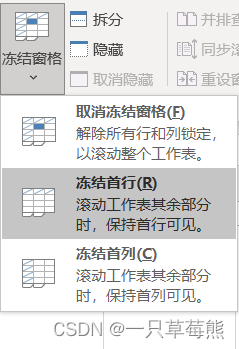
Excel的相关操作
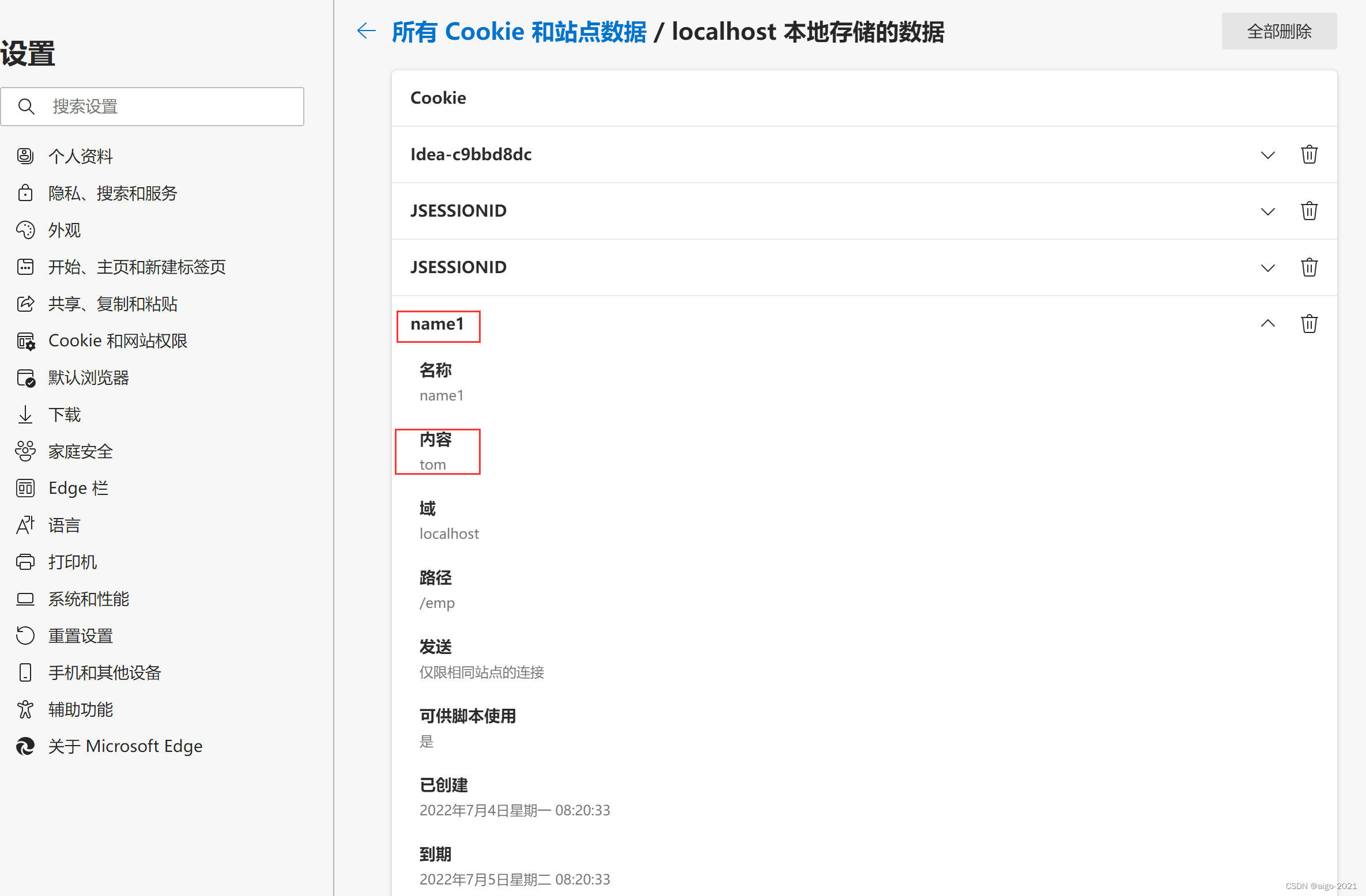
Cookie技术&Session技术&ServletContext对象
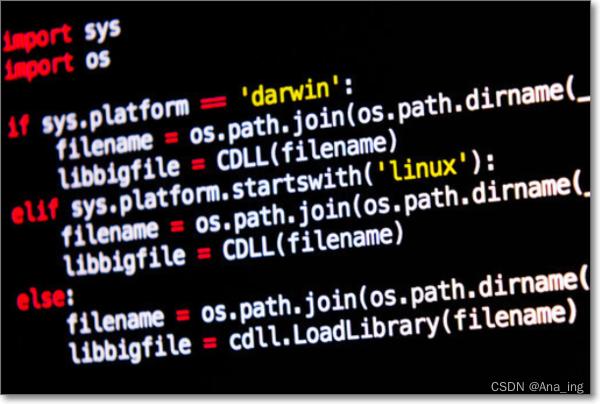
变量的命名规则十二条
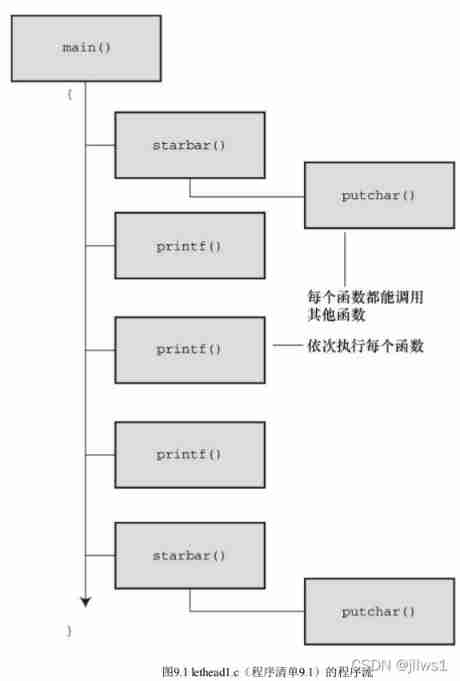
Fundamentals of C language 9: Functions

Games101 Lesson 7 shading 1 Notes

Set picture annotation in markdown

QT color is converted to string and uint

Go learning -- implementing generics based on reflection and empty interfaces

杰理之AD 系列 MIDI 功能说明【篇】
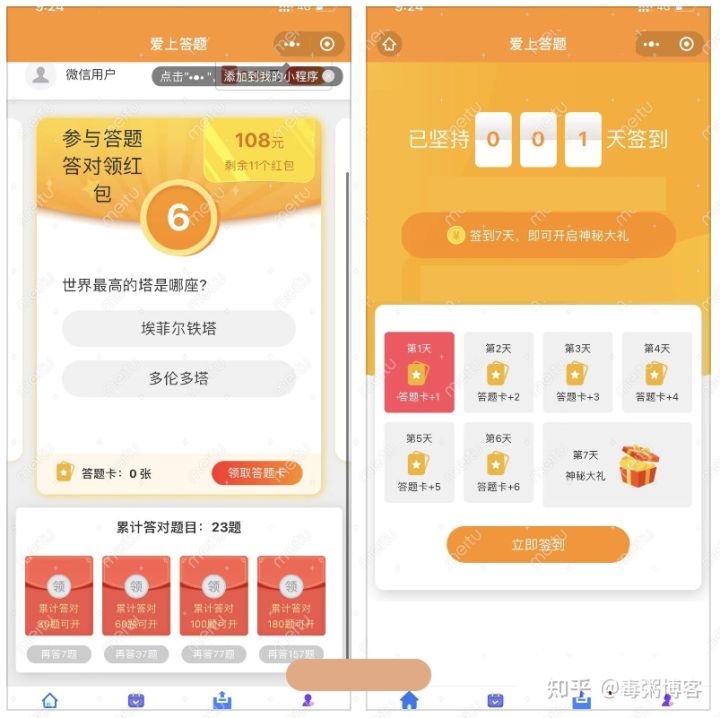
Wechat brain competition answer applet_ Support the flow main belt with the latest question bank file
随机推荐
智能终端设备加密防护的意义和措施
Wechat official account infinite callback authorization system source code, launched in the whole network
Summary of Digital IC design written examination questions (I)
The author is dead? AI is conquering mankind with art
数字IC设计笔试题汇总(一)
OpenJudge NOI 2.1 1749:数字方格
How are the open source Netease cloud music API projects implemented?
Jerry's ad series MIDI function description [chapter]
1091: two or three things in childhood (multi instance test)
Methods for JS object to obtain attributes (. And [] methods)
Word delete the contents in brackets
You deserve this high-value open-source third-party Netease cloud music player
Idea console color log
Cookie技术&Session技术&ServletContext对象
Scala language learning-08-abstract classes
NiO programming introduction
js对象获取属性的方法(.和[]方式)
杰理之需要修改 gatt 的 profile 定义【篇】
Ali's redis interview question is too difficult, isn't it? I was pressed on the ground and rubbed
Wechat brain competition answer applet_ Support the flow main belt with the latest question bank file

